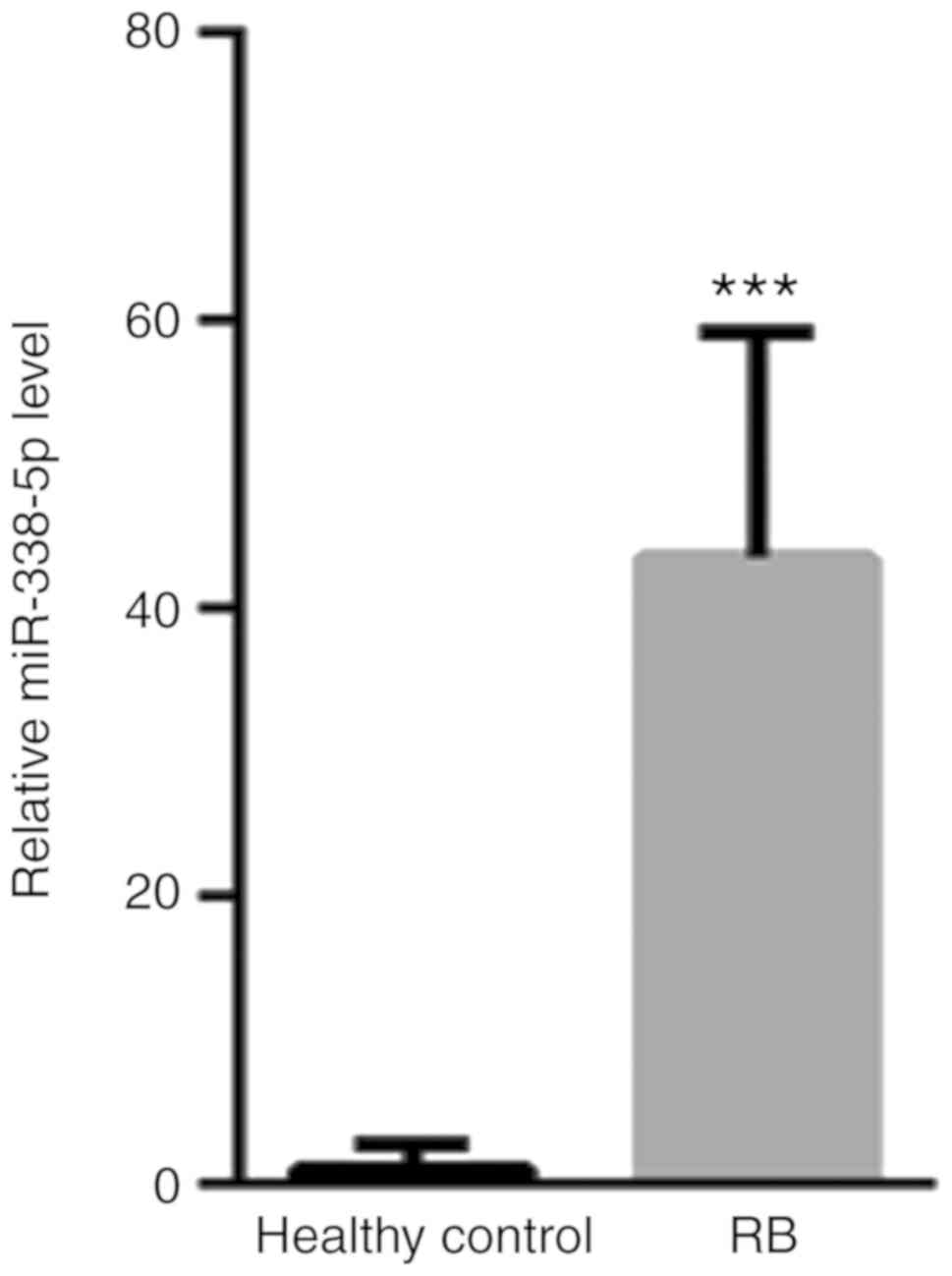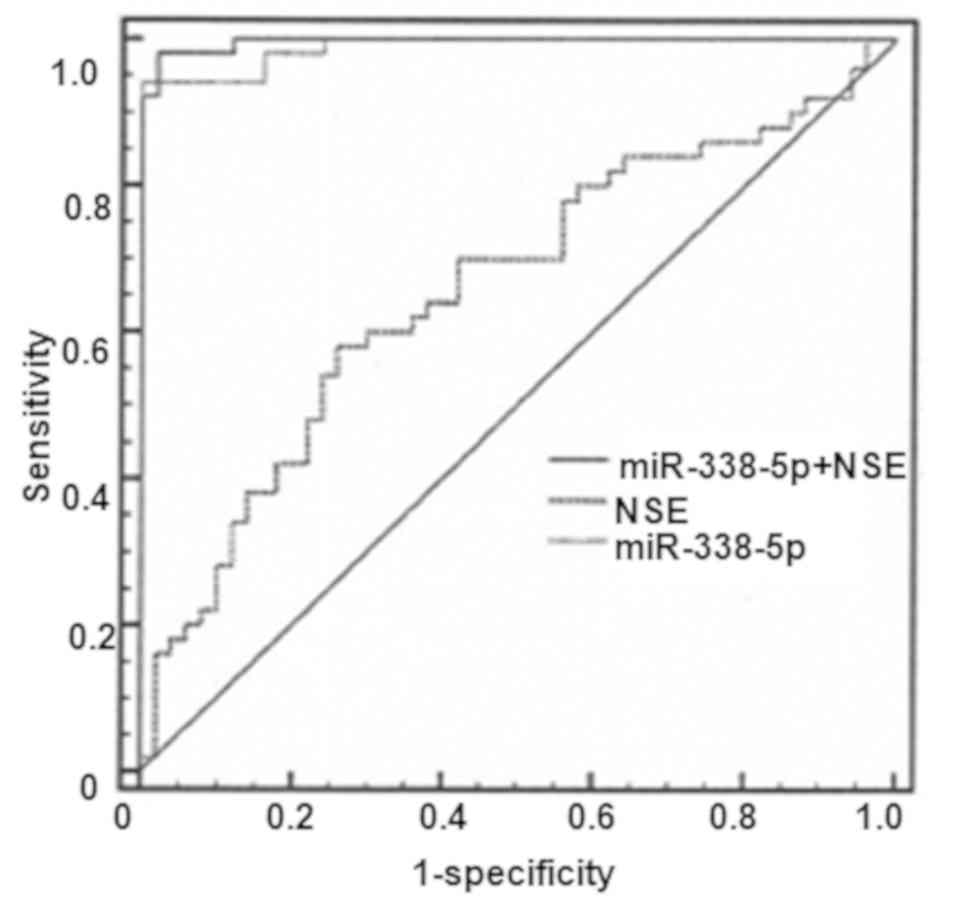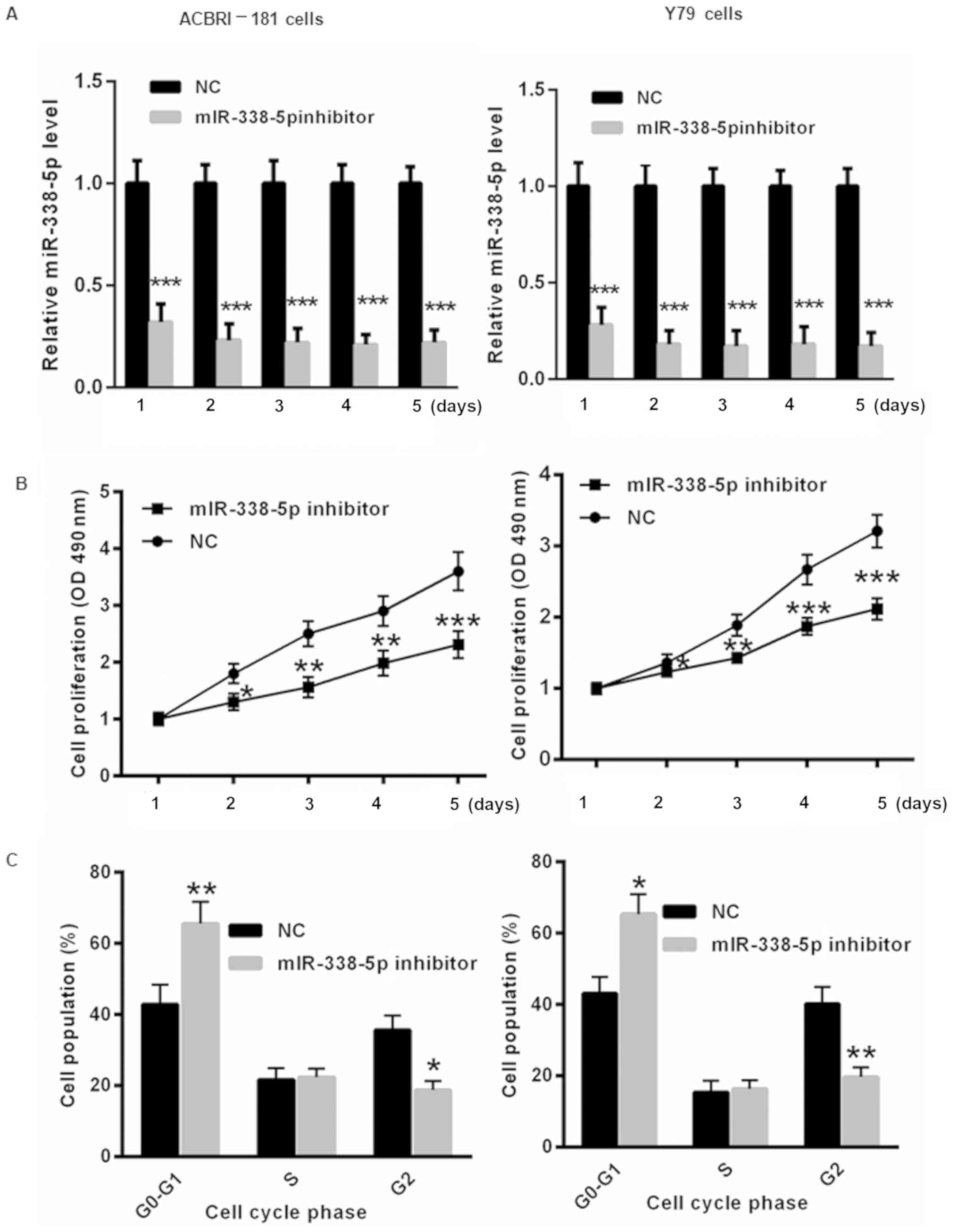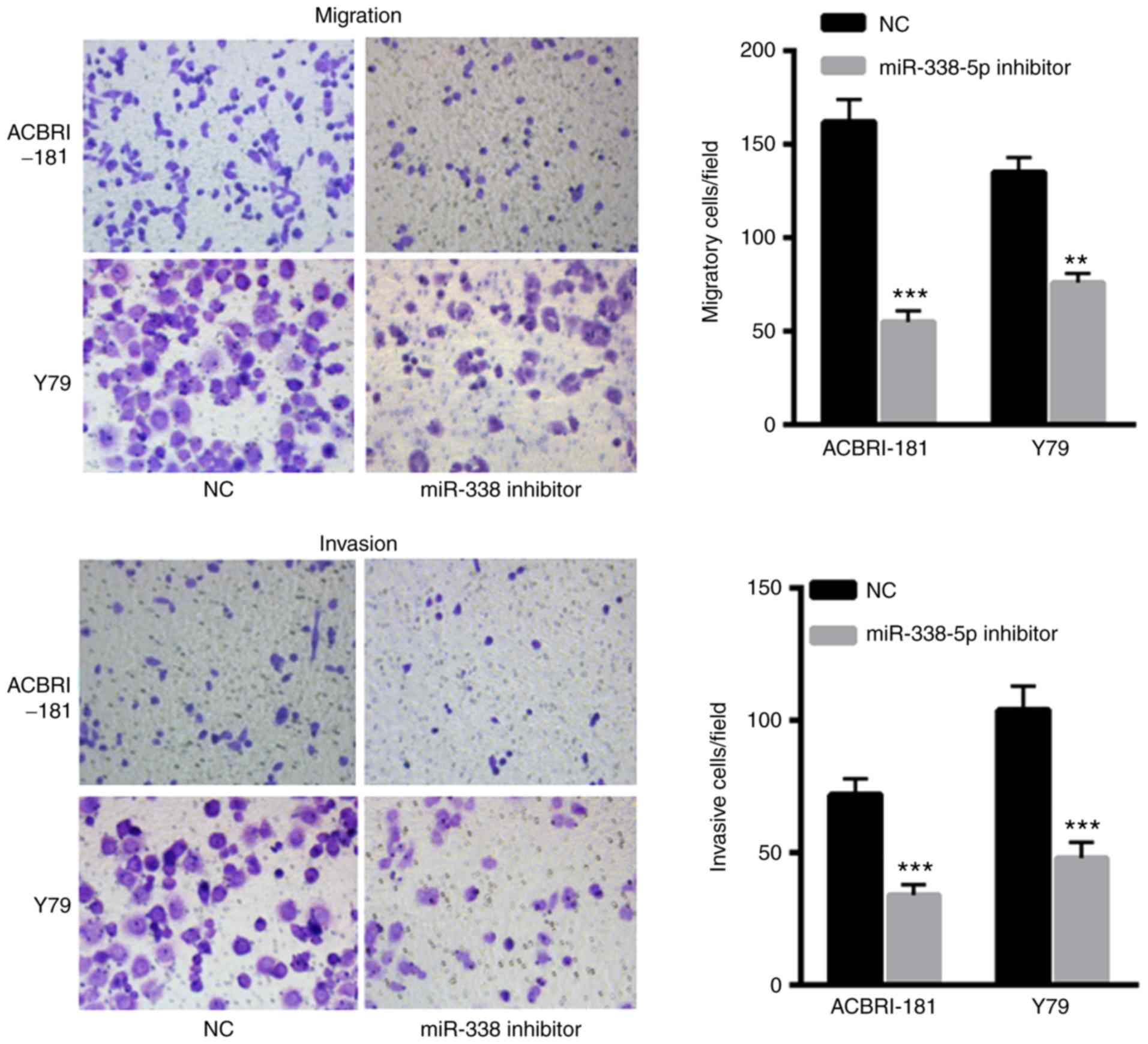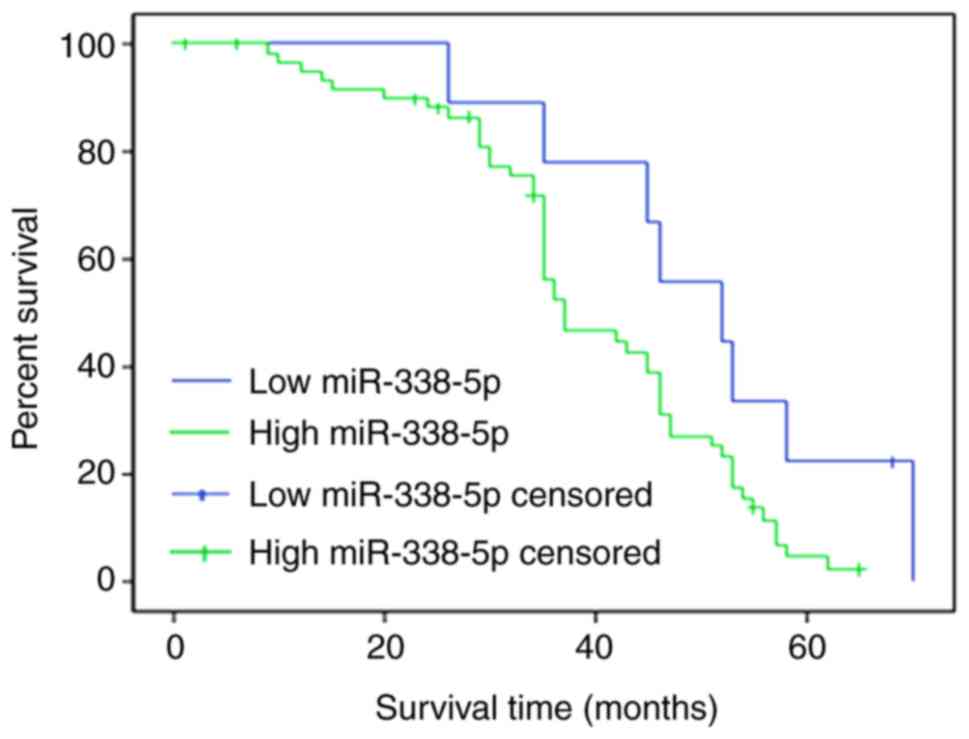Serum miR‑338‑5p has potential for use as a tumor marker for retinoblastoma
Retraction in: /10.3892/ol.2024.14347
- Authors:
- Published online on: May 7, 2019 https://doi.org/10.3892/ol.2019.10331
- Pages: 307-313
-
Copyright: © Zhou et al. This is an open access article distributed under the terms of Creative Commons Attribution License.
Abstract
Introduction
Retinoblastoma RB) is the most common intraocular malignancy in infants and young children worldwide (1,2). RB usually occurs in children <3 years of age and can affect one or both eyes (3). It is reported that the incidence of RB globally is ~1 in 15,000–20,000 live births, with as many as 9.32 cases per million children between 0 and 5 years of age worldwide annually (3).
Identification of the pathological features associated with RB is considered the gold standard for diagnosis (4). For those children who are suspected to have RB, clinicians rely mainly on clinical manifestations and auxiliary examinations to establish a diagnosis (5). Ultrasound and computed tomography examination can indicate the presence of intraocular tumors and the possible calcification points in the lesions, thus providing a basis for the clinical diagnosis of RB (6). Despite the increasing sophistication of examination methods, there remain cases of RB that cannot be diagnosed due to the clinical manifestations that are markedly similar to other ocular disorders (1). In a laboratory diagnosis, neuron-specific enolase (NSE) is a tumor marker widely used in the clinical setting to determine the presence of RB (7); however, this marker also has a certain value for diagnosing neuroblastoma, non-small cell lung cancer and other malignant tumors, leading to a high misdiagnosis and false positive rate when used to diagnose RB (8). Lactate dehydrogenase and carcinoembryonic antigen have also been used to assist in the diagnosis of RB, but the sensitivity and specificity of these laboratory indicators are poor (9). Therefore, identification of a more sensitive and specific molecular biology index is required in order to improve the early diagnosis rate of RB and save the lives of children.
MicroRNA (miRNA) is a non-coding endogenous small molecule of RNA 18–25 nucleotides in length (10). It binds to the target mRNA either completely or incompletely, and regulates the expression of downstream genes at the transcriptional or translational level, thus participating in embryonic development, cell proliferation, differentiation, apoptosis and fat metabolism (10). With the in-depth study of tumors and associated miRNAs, circulating miRNAs have attracted increasing attention. It has been revealed that miRNA expression can be detected in serum, cerebrospinal fluid and a number of other bodily fluids and may derive from the active release of apoptotic, necrotic or live tumor cells, although the precise origin of circulating miRNAs has not yet been universally identified (11–13). The presence of circulating miRNAs within bodily fluids alongside proteins and other particles makes them resistant to degradation via ribonucleases (13). Even under extreme conditions, such as strongly acidic, strongly alkaline or repeated freezing and thawing, expression of miRNA remains stable. This important characteristic of miRNA suggests that serum or serum miRNAs may have objective conditions as tumor markers for application in the clinical setting (13,14).
Abnormal expression of miR-338-5p has been widely observed in various types of cancer (15,16). In patients with colorectal cancer, upregulated serum miR-338-5p was suggested to be a potential circulating marker (15). Additionally, miR-338-5p was revealed as being increased in melanoma tissues and glioma (17,18). However, to the best of our knowledge, the possibility of whether miR-338-5p is dysregulated in RB has never been investigated. The aim of the present study was to evaluate the expression of miR-338-5p in RB, thereby revealing whether it could be used as a potential biomarker to screen patients with RB from healthy controls.
Materials and methods
Patient samples
Peripheral blood (4 ml) was collected from 65 patients with RB (male/female: 34/31; mean age: 3.8±1.7 years; age range: 2.2–5.8 years) and 65 healthy controls (male/female: 29/36; mean age: 3.5±1.6 years; 1.9–6.1 years) at Peking University Third Hospital (Beijing, China) between December 2016 and November 2017. Inclusion criteria were as follows: Patients who did not receive any treatment prior to surgery, patients whose tissue sections were diagnosed by the chief physician and patients with complete clinical data. Exclusion criteria were as follows: Patients with a history of mental disease and a family history of mental disease, or patients with complicated severe heart, lung, liver and renal dysfunction. According to the International Classification Standard for Retinoblastoma (ICRB) (19), patients with RB were divided into stages A, B and C (12 patients) or stages D and E (53 patients) (Table I). Written informed consent was obtained from each patient. The experimental protocol was preapproved by the Medical Ethics Committee of Peking University Third Hospital.
Cell culture
A human retinoblastoma cell line Y79 was purchased from the American Type Culture Collection (Manassas, VA, USA). Y79 cells were cultured for 24 h to 70% confluence in RPMI-1640 medium (Gibco; Thermo Fisher Scientific, Inc., Waltham, MA, USA) supplemented with 10% fetal bovine serum (FBS; HyClone; GE Healthcare Life Sciences, Logan, UT, USA), 100 U/ml penicillin and 100 mg/ml streptomycin at 37°C under normoxic conditions of 100% humidity, 95% air and 5% CO2.
Human normal retinal vascular endothelial cell line ACBRI-181 is a commercially available cell line (Cell Systems, Kirkland, WA, USA). For the culture of ACBRI-181 for 48 h, a special medium was used, consisting of Complete Serum-Free (CSC) medium with RocketFuel™, supplemented with 10% FBS (HyClone; GE Healthcare Life Sciences), 100 U/ml penicillin and 100 mg/ml streptomycin at 37°C under normoxic conditions of 100% humidity, 95% air and 5% CO2.
Cell transfection
The miR-338-5p mimic, miR-338-5p inhibitor and miR-negative control (NC) were all purchased from GenePharma (Shanghai, China). Increased or decreased miR-338-5p expression was achieved by transfection of miR-338-5p mimic or miR-338-5p inhibitors, respectively. Transfection was performed using the instructions of HiPerfect Transfection reagent (Qiagen, Inc., Valencia, CA, USA), according to the manufacturer's protocol, and each group of cells was harvested 24–48 h after transfection for further assays.
Reverse transcription-quantitative polymerase chain reaction (RT-qPCR)
The serum was collected from the blood samples of the patients included in the study. For preparation of the serum samples, the blood was centrifuged at 3,000 × g at 4°C for 15 min. Total RNA was isolated from serum using RNAVzol reagent (Vigorous Biotechnology Beijing Co., Ltd., Beijing, China) according to the manufacturer's protocol. RNA purity was assessed at optical density (OD)260/OD280 (values, 1.7–2.0). RNA (1 µg) was reverse-transcribed into cDNA using Moloney Murine Leukemia Virus reverse transcription enzyme (Applied Biosystems; Thermo Fisher Scientific, Inc.) with specific primers, and amplified via qPCR using a Rotor-Gene 3000 Real-Time PCR system (Corbett Life Sciences; Qiagen, Inc., Valencia, CA, USA). The temperature protocol used for RT was as follows: 72°C for 10 min, 42°C for 60 min, 72°C for 5 min and 95°C for 2 min. To quantify the relative mRNA levels, qPCR was performed using SYBR® Green Supermix (Bio-Rad Laboratories, Inc., Hercules, CA, USA) in an iCycler iQ Real-Time PCR Detection system. The PCR amplifications were performed in a 10 µl reaction system containing 5 µl SYBR Green Supermix, 0.4 µl forward primer, 0.4 µl reverse primer, 2.2 µl double-distilled water and 2 µl template cDNA. Thermocycling conditions were as follows: 95°C for 10 min followed by 40 cycles of 95°C for 15 sec and 60°C for 1 min. Relative mRNA expression was normalized to U6 using the 2−∆∆Cq method (20). Primer sequences are as follows: miR-338-5p-RT, 5′-GTCGTATCCAGTGCAGGGTCCGAGGTATTCGCACTGGATACGACCACTC-3′; U6-RT, 5′-GTCGTATCCAGTGCAGGGTCCGAGGTATTCGCACTGGATACGACAAAATG-3′; miR-338-5p, forward 5′-AACAATATCCTGGTGCTG-3′; U6, forward 5′-GCGCGTCGTGAAGCGTTC-3′; universal reverse primer, 5′-GTGCAGGGTCCGAGGT-3′.
Cell proliferation assay
Following transfection for 72 h, cells were seeded into 96-well culture plates at a density of 2×104 cells/well. After 3–4 h when cells had adhered to each well, 100 µl RPMI-1640 medium supplemented with 10% FBS, 100 U/ml penicillin and 100 mg/ml streptomycin and 10 µl Cell Containing Kit-8 (Dojindo Laboratories, Kumamoto, Japan) were added. The culture medium was placed in 5% CO2 at 37°C for 1, 2, 3, 4 and 5 days. A microplate reader (Molecular Devices, LLC, Sunnyvale, CA, USA) was used to determine the OD450 value.
Cell migration and invasion assays
Cell migration assays were performed using Boyden chambers (8 µm pore filter; Corning Inc., Corning, NY, USA). For the cell invasion assay, the filter surfaces were precoated with Matrigel (BD Biosciences, San Jose, CA, USA). In brief, ACBRI-181 or Y79 cells were seeded at a density of 1×105 cells/well for 24 h and then were transfected with NC or miR-338-5p inhibitor in the upper chamber in 500 µl CSC medium or RPMI-1640 medium without FBS. Cell culture medium (600 µl) with 20% FBS was plated in the lower chamber. After 48 h of incubation, non-migratory and non-invasive cells were removed using cotton swabs. The migratory or invasive cells located on the lower side of the chamber were fixed in methanol for 30 min at 37°C and stained with 0.5% crystal violet for 1 h at 37°C. Stained cells were counted in five random fields using fluorescence microscopy (magnification, ×40). All experiments were performed in triplicate.
Cell cycle assays
ACBRI-181 or Y79 cells (~1×106) were trypsinized, washed twice with PBS and fixed in 70% ice-cold ethanol for 1 h. The samples were centrifuged at 300 × g for 5 min at 4°C, the ethanol removed and they were exposed to 100 mg/ml RNaseA (Sigma-Aldrich; Merck KGaA, Darmstadt, Germany) for 30 min at 37°C. Cell cycle was analyzed using cell cycle analysis kit (cat. no., KGA512; Nanjing KeyGen Biotech Co., Ltd., Nanjing, China), according to the manufacturer's protocols. Cellular DNA was stained with propidium iodide (Nanjing KeyGen Biotech Co., Ltd.) at 37°C for 30 min. Cell-cycle distributions were determined by flow cytometry using a BD FACSCalibur system (BD Biosciences, Franklin Lakes, NJ, USA) and data was analyzed using the ModFit software version 4.1 (Verity Software House, Inc., Topsham, ME, USA).
Statistical analysis
Data are presented as the mean ± standard deviation. Two-tailed unpaired Student's t-tests were used for comparisons between two groups. Analysis of variance followed by Tukey's post hoc test were used for multiple group comparisons using SPSS (version 13; SPSS, Inc., Chicago, IL, USA). Receiver operator characteristic (ROC) curves were used to assess the potential of miR-338-5p as a biomarker, and the area under the curve (AUC) was recorded. To evaluate the diagnostic value of serum miR-338-5p for patients with RB, ROC analysis was performed to investigate the application of miR-338-5p alone or the combination of miR-338-5p and NSE. The cut-off value was calculated as: Youden index=sensitivity-(1-specificity). The test value corresponding to the maximum Youden index value can be used as cut-off value. To assess the association between serum miR-338-5p and clinical features as presented in Tables I and II, the χ2 test was applied. P<0.05 was considered to indicate a statistically significant difference.
Results
Clinical data and characteristics of subjects
For patients with RB, 12 were classed as stages A, B and C, and 53 were classed as stages D and E. No significant difference was identified in age (P=0.196) or sex (P<1.000) between healthy controls and patients with RB (Table I).
Increased serum miR-338-5p in patients with RB
First, the presence of serum miR-338-5p in patients with RB and healthy controls was evaluated. The levels of serum miR-338-5p for all the patient samples and controls are presented in Fig. 1. Compared with healthy controls (1±1.86), the level of serum miR-338-5p was significantly increased (43.54±15.6) (Fig. 1).
Diagnostic value of serum miR-338-5p in patients with RB
As presented in Fig. 2, the AUC value for NSE was 0.660 [95% confidence interval (CI), 0.558–0.752; P=0.0036] with a cut-off value of 14.7, a sensitivity level of 58% and a specificity level of 74%. The AUC of NSE reached 0.989 with a cut-off value of 15.9, a sensitivity level of 94% and a specificity level of 100%. In contrast, the AUC value for combined use of miR-338-5p and NSE was 0.996 (95% CI, 0.957–1.000; P<0.0001), with a sensitivity of 98% and a specificity of 100%.
Association between serum miR-338-5p and clinical features
The association between serum miR-338-5p and clinical features was then analyzed. There was a loss of follow-up data from 15 patients with RB, as they could not be contacted, and these were not included in the analyses presented in Table II. No significant associations were identified between serum miR-338-5p and age, sex, laterality or International Intraocular Retinoblastoma Classification clinical stage (Table II).
Decreased miR-338-5p inhibits RB cell proliferation and results in cell cycle arrest
To further evaluate the underlying molecular mechanism by which miR-338-5p affects the progression of RB, miR-338-5p inhibitor or NC was transfected into ACBRI-181 and Y79 cells for 1, 2, 3, 4 and 5 days. First, the transfection efficiency of the miR-338-5p inhibitor in ACBRI-181 and Y79 cells was determined. As presented in Fig. 3A, transfection of miR-338-5p inhibitor significantly decreased the level of miR-338-5p in ACBRI-181 and Y79 cells for 1, 2, 3, 4 and 5 days. Furthermore, decreasing miR-338-5p induced slower proliferation of ACBRI-181 and Y79 cells at 2, 3, 4 and 5 days compared with those in the NC group (Fig. 3B). Flow cytometric analysis indicated that the transfection with miR-338-5p inhibitor for 2 days led to significant cell cycle arrest in ACBRI-181 and Y79 cells compared with in the NC group (Fig. 3C).
Decreased miR-338-5p decreases the invasive and migratory capacity of ACBRI-181 and Y79 cells
The effects of miR-338-5p on ACBRI-181 and Y79 cells were also evaluated. The results indicated that transfection with miR-338-5p inhibitor significantly decreased the migration and invasion of ACBRI-181 and Y79 cells compared with in the NC group (Fig. 4A and B, respectively), indicating the oncogenic role of miR-338-5p in the progression of RB.
Increased miR-338-5p results in a poor survival rate for patients with RB
The overall survival rate was evaluated for patients with RB with high miR-338-5p (>21.77) or low miR-338-5p (≤21.77) levels. To differentiate the high and low levels, the mean expression of miR-338-5p was calculated. A total of 50 patients completed the follow-up, and the follow-up success rate was 77.0%. Survival rates at 20, 40 and 60 months in the miR-338-5p low expression group were 88.5, 79.4 and 68.9%, respectively, whereas survival rates at 20, 40 and 60 months in the miR-338-5p high expression group were 79.8, 68.2 and 43.6%, which were significantly lower compared with those in miR-338-5p low expression group (P<0.05; Fig. 5).
Discussion
With the increase in research on miRNAs and tumors, the suggestion that miRNAs can be used as novel diagnostic and prognostic tools and therapeutic targets has gradually been accepted (21). In the clinical setting, it is difficult to detect early-stage tumors in children (22). Chemotherapy easily induces drug resistance, and side effects of drugs can often cause secondary injury (22). All these factors markedly affect the diagnosis and treatment of childhood tumors. As the intrinsic association between miRNAs and tumors is gradually revealed, miRNAs have been identified to be equally applicable to tumors in childhood (22,23).
In the present study, RT-qPCR was used to detect the expression of miRNA-338-5p in the serum of 50 patients with RB and healthy controls. Combining the clinical data of the participants, it was revealed that there were no significant differences in the expression of miR-338-5p between the age, sex, tumor stage and binocular disease of patients with RB (Table I). To determine the clinical value of serum miRNAs as RB tumor markers, the ROC curve of serum miRNA-338-5p combined with traditional tumor markers was established for the first time, to the best of our knowledge, in the present study. By comparing their respective AUC values, it was revealed that serum miR-338-5p combined with NSE had a larger curvilinear area compared with that of serum miR-338-5p alone when diagnosing RB. In the present study, the ROC curves for the miR-338-5p indicated a poor diagnostic value for each miRNA alone, although the P-value indicated some significance for the diagnosis of RB. The ROC of NSE alone was similar to that of miR-338-5p+NSE, which demonstrated the unreliability. However, an upregulation of AUC resulted in significantly decreased possibility of misdiagnosis, which would be expected if the accuracy improves; therefore, it is important to combine miR-338-5p+NSE for the diagnosis of RB. These results suggest that serum miR-338-5p may be of clinical value when the presence of RB is suspected, particularly when combined with NSE, and may improve the early diagnosis rate of RB.
The results of the present study indicated that there were no significant differences in the expression of serum miR-338-5p and the age, sex, binocular disease or tumor stage of children with RB. We hypothesize that serum miR-338-5p may serve a role in the signaling pathway of RB initiation. Once the tumor develops, the expression of miR-338-5p in serum will no longer change. It should be noted that the limited sample size of this experiment, resulting in the lack of abundant data on RB grouping, may be a possible reason for this result.
In addition, the oncogenic role of miR-338-5p was also investigated using an in vitro assay. Suppression of miR-338-5p induced slower proliferation of ACBRI-181 and Y79 cells at 2, 3, 4 and 5 days compared with that of the NC group. Flow cytometric analysis indicated that transfection with miR-338-5p inhibitor led to significant cell cycle arrest in ACBRI-181 and Y79 cells compared with that of the NC group. Furthermore, transfection with miR-338-5p inhibitor significantly decreased migration and invasion of ACBRI-181 and Y79 cells, revealing the oncogenic role of miR-338-5p in the progression of RB. Previous studies have indicated that miR-338-5p functions as an oncogenic miRNA in melanoma tissues via targeting cluster of differentiation 82, and targeting teashirt zinc finger homeobox 3 and matrix metalloproteinase-2 in glioma (17,18). In future studies, we will further investigate whether these targets were important for miR-338-5p in the progression of RB. However, the present study also has the following shortcomings: i) Chromatin immunoprecipitation technology was not used for the patients with RB and normal control serum samples for preliminary screening of miRNAs, limiting the selection of miRNAs tested; ii) the sample size included in the present study requires expansion in other studies so that it can be more valuable in clinical staging by the comparative analysis of experimental results; iii) RB tissue samples are required for detection, thereby elucidating the association between RB tissue and serum miR-338-5p expression.
In conclusion, the low expression of miR-338-5p in the serum of patients with RB suggests that it may be involved in the formation of RB. Serum miR-338-5p has the potential to be a tumor marker of RB, and, in combination with NSE, miR-338-5p may improve the early diagnosis rate of RB.
Acknowledgements
Not applicable.
Funding
The present study was supported by the Beijing Science and Technology Fund Project (grant no. B79495-03).
Availability of data and materials
The datasets used and/or analyzed during the present study are available from the corresponding author on reasonable request.
Authors' contributions
PZ wrote the paper, performed the experiments and analyzed the data. XL designed the experiments, analyzed the data. Both authors approved the final version of the manuscript.
Ethics approval and consent to participate
The present study was approved by the Ethics Committee of Peking University Third Hospital, Beijing, China, as stipulated by The Declaration of Helsinki (1964), with written informed consent for the use of the specimens obtained from all enrolled patients.
Patient consent for publication
Not applicable.
Competing interests
The authors declare that they have no competing interests.
References
|
Giacalone M, Mastrangelo G and Parri N: Point-of-care ultrasound diagnosis of retinoblastoma in the emergency department. Pediatr Emerg Care. 34:599–601. 2018. View Article : Google Scholar : PubMed/NCBI | |
|
Stathopoulos C, Moulin A, Gaillard MC, Beck-Popovic M, Puccinelli F and Munier FL: Conservative treatment of diffuse infiltrating retinoblastoma: Optical coherence tomography-assisted diagnosis and follow-up in three consecutive cases. Br J Ophthalmol. Jul 26–2018.(Epub ahead of print). doi: 10.1136/bjophthalmol-2018-312546. View Article : Google Scholar : PubMed/NCBI | |
|
Al-Nawaiseh I, Ghanem AQ and Yousef YA: Familial retinoblastoma: Raised awareness improves early diagnosis and outcome. J Ophthalmol. 2017:50539612017.PubMed/NCBI | |
|
Jenkinson H: Retinoblastoma: Diagnosis and management-the UK perspective. Arch Dis Child. 100:1070–1075. 2015. View Article : Google Scholar : PubMed/NCBI | |
|
Fabian ID, Puccinelli F, Gaillard MC, Beck-Popovic M and Munier FL: Diagnosis and management of secondary epipapillary retinoblastoma. Br J Ophthalmol. 101:1412–1418. 2017. View Article : Google Scholar : PubMed/NCBI | |
|
Dehainault C, Golmard L, Millot GA, Charpin A, Laugé A, Tarabeux J, Aerts I, Cassoux N, Stoppa-Lyonnet D, Gauthier-Villars M and Houdayer C: Mosaicism and prenatal diagnosis options: Insights from retinoblastoma. Eur J Hum Genet. 25:381–383. 2017. View Article : Google Scholar : PubMed/NCBI | |
|
Parrilla-Vallejo M, Perea-Pérez R, Relimpio-López I, Montero-de-Espinosa I, Rodríguez-de-la-Rúa E, Terrón-León JA, Díaz-Granda MJ, Coca-Gutiérrez L and Ponte-Zuñiga B: Retinoblastoma: The importance of early diagnosis. Arch Soc Esp Oftalmol. 93:423–430. 2018. View Article : Google Scholar : PubMed/NCBI | |
|
Ramírez-Ortiz MA, Lansingh VC, Eckert KA, Haik BG, Phillips BX, Bosch-Canto V, González-Pérez G, Villavicencio-Torres A and Etulain-González A: Systematic review of the current status of programs and general knowledge of diagnosis and management of retinoblastoma. Bol Med Hosp Infant Mex. 74:41–54. 2017.PubMed/NCBI | |
|
Shah PK, Sripriya S, Narendran V and Pandian AJ: Prenatal genetic diagnosis of retinoblastoma and report of RB1 gene mutation from India. Ophthalmic Genet. 37:430–433. 2016. View Article : Google Scholar : PubMed/NCBI | |
|
Wu L, Chen Z and Xing Y: miR-506-3p inhibits cell proliferation, induces cell cycle arrest and apoptosis in retinoblastoma by directly targeting NEK6. Cell Biol Int. Aug 6–2018.(Epub ahead of print). doi: 10.1002/cbin.11041. View Article : Google Scholar | |
|
Clarke JI, Forootan SS, Lea JD, Howell LS, Rodriguez JM, Kipar A, Goldring CE, Park BK, Copple IM and Antoine DJ: Circulating levels of miR-122 increase post-mortem, particularly following lethal dosing with pentobarbital sodium: Implications for pre-clinical liver injury studies. Toxicol Res (Camb). 6:406–411. 2017. View Article : Google Scholar : PubMed/NCBI | |
|
Hu HL, Nie ZQ, Lu Y, Yang X, Song C, Chen H, Zhu S, Chen BB, Huang J, Geng S and Zhao S: Circulating miR-125b but not miR-125a correlates with acute exacerbations of chronic obstructive pulmonary disease and the expressions of inflammatory cytokines. Medicine (Baltimore). 96:e90592017. View Article : Google Scholar : PubMed/NCBI | |
|
Copier CU, León L, Fernández M, Contador D and Calligaris SD: Circulating miR-19b and miR-181b are potential biomarkers for diabetic cardiomyopathy. Sci Rep. 7:135142017. View Article : Google Scholar : PubMed/NCBI | |
|
D'Agostino M, Martino F, Sileno S, Barillà F, Beji S, Marchetti L, Gangi FM, Persico L, Picozza M, Montali A, et al: Circulating miR-200c is up-regulated in paediatric patients with familial hypercholesterolaemia and correlates with miR-33a/b levels: Implication of a ZEB1-dependent mechanism. Clin Sci (Lond). 131:2397–2408. 2017. View Article : Google Scholar : PubMed/NCBI | |
|
Bilegsaikhan E, Liu HN, Shen XZ and Liu TT: Circulating miR-338-5p is a potential diagnostic biomarker in colorectal cancer. J Dig Dis. 19:404–410. 2018. View Article : Google Scholar : PubMed/NCBI | |
|
Xing Z, Yu L, Li X and Su X: Anticancer bioactive peptide-3 inhibits human gastric cancer growth by targeting miR-338-5p. Cell Biosci. 6:532016. View Article : Google Scholar : PubMed/NCBI | |
|
Long J, Luo J and Yin X: miR-338-5p promotes the growth and metastasis of malignant melanoma cells via targeting CD82. Biomed Pharmacother. 102:1195–1202. 2018. View Article : Google Scholar : PubMed/NCBI | |
|
Li Y, Huang Y, Qi Z, Sun T and Zhou Y: miR-338-5p promotes glioma cell invasion by regulating TSHZ3 and MMP2. Cell Mol Neurobiol. 38:669–677. 2018. View Article : Google Scholar : PubMed/NCBI | |
|
Shields CL, Mashayekhi A, Au AK, Czyz C, Leahey A, Meadows AT and Shields JA: The International Classification of Retinoblastoma predicts chemoreduction success. Ophthalmology. 113:2276–2280. 2006. View Article : Google Scholar : PubMed/NCBI | |
|
Livak KJ and Schmittgen TD: Analysis of relative gene expression data using real-time quantitative PCR and the 2(-Delta Delta C(T)) method. Methods. 25:402–408. 2001. View Article : Google Scholar : PubMed/NCBI | |
|
Gutierrez-Camino A, Martin-Guerrero I, Dolzan V, Jazbec J, Carbone-Bañeres A, Garcia de Andoin N, Sastre A, Astigarraga I, Navajas A and Garcia-Orad A: Involvement of SNPs in miR-3117 and miR-3689d2 in childhood acute lymphoblastic leukemia risk. Oncotarget. 9:22907–22914. 2018. View Article : Google Scholar : PubMed/NCBI | |
|
Wu T, Lin Y and Xie Z: MicroRNA-1247 inhibits cell proliferation by directly targeting ZNF346 in childhood neuroblastoma. Biol Res. 51:132018. View Article : Google Scholar : PubMed/NCBI | |
|
Zakrzewska M, Fendler W, Zakrzewski K, Sikorska B, Grajkowska W, Dembowska-Bagińska B, Filipek I, Stefańczyk Ł and Liberski PP: Altered MicroRNA expression is associated with tumor grade, molecular background and outcome in childhood infratentorial ependymoma. PLoS One. 11:e01584642016. View Article : Google Scholar : PubMed/NCBI |



